A Compact and Low-Profile Curve-Feed Complementary Split-Ring Resonator Microwave Sensor for Solid Material Detection
Abstract
1. Introduction
2. Curve-Feed CSRR Design and Validation
2.1. Sensor Design Configuration
2.2. Parametric Study of TR Curve-Feed CSRR Sensor
3. Sample under Tests (SUTs)
3.1. Analysis of Size and Volume of SUTs
3.2. Analysis of Solid SUTs
4. Fabrication, Measurement, and Characterisations
4.1. Curve-Feed Sensor Fabrication
4.2. Solid Sample under Tests (SUTs) Measurement
5. Data Analysis
5.1. Repeatability of Sample under Tests
5.2. Sensitivity
6. Conclusions
Author Contributions
Funding
Institutional Review Board Statement
Informed Consent Statement
Data Availability Statement
Conflicts of Interest
References
- Lisovsky, V.V. Automatic control of moisture in agricultural products by methods of microwave aquametry. Meas. Sci. Technol. 2007, 18, 1016–1021. [Google Scholar] [CrossRef]
- Jonasson, S.P.; Jensen, B.S.; Johansen, T.K. Study of split-ring resonators for use on a pharmaceutical drug capsule for microwave activated drug release. In Proceedings of the 2012 42nd European Microwave Conference, Amsterdam, The Netherlands, 29 October–1 November 2012; IEEE: Amsterdam, The Netherlands, 2012. [Google Scholar] [CrossRef]
- Tiuri, M. Microwave sensor applications in industry. In Proceedings of the 1987 17th European Microwave Conference, Rome, Italy, 7–11 September 1987; IEEE: Rome, Italy, 1987. [Google Scholar]
- Wang, C.; Ali, L.; Meng, F.-Y.; Adhikari, K.K.; Zhou, Z.L.; Wei, Y.C.; Zou, D.Q.; Yu, H. High-Accuracy Complex Permittivity Characterization of Solid Materials Using Parallel Interdigital Capacitor-Based Planar Microwave Sensor. IEEE Sens. J. 2020, 21, 6083–6093. [Google Scholar] [CrossRef]
- Al-Gburi, A.J.A.; Zakaria, Z.; Ibrahim, I.M.; Halim, E.B.A. Microstrip Patch Antenna Arrays Design for 5G Wireless Backhaul Application at 3.5 GHz. In Recent Advances in Electrical and Electronic Engineering and Computer Science; Springer: Singapore, 2022; pp. 77–88. [Google Scholar]
- Li, Z.; Meng, Z.; Soutis, C.; Wang, P.; Gibson, A. Detection and analysis of metallic contaminants in dry foods using a microwave resonator sensor. Food Control. 2021, 133, 108634. [Google Scholar] [CrossRef]
- Gao, R.; Yu, W.; Deng, H.; Ku, H.S.; Li, Z.; Wang, M.; Miao, X.; Lin, Y.; Deng, C. Epitaxial titanium nitride microwave resonators: Structural, chemical, electrical, and microwave properties. Phys. Rev. Mater. 2022, 6, 036202. [Google Scholar] [CrossRef]
- Chernousov, Y.D.; Ivannikov, V.I.; Shebolaev, I.V.; Bolotov, V.A.; Tanashev, Y.Y.; Parmon, V.N. Characteristics of a chemical reactor that is a loaded microwave resonator. J. Commun. Technol. Electron. 2009, 54, 231–233. [Google Scholar] [CrossRef]
- Eremenko, Z.E.; Ganapolskii, E.M.; Vasilchenko, V.V. Exact-calculated resonator method for permittivity measurement of high loss liquids at millimetre wavelength. Meas. Sci. Technol. 2005, 16, 1619. [Google Scholar] [CrossRef]
- Morales-Lovera, H.-N.; Olvera-Cervantes, J.-L.; Perez-Ramos, A.-E.; Corona-Chavez, A.; Saavedra, C.E. Microstrip sensor and methodology for the determination of complex anisotropic permittivity using perturbation techniques. Sci. Rep. 2022, 12, 2205. [Google Scholar] [CrossRef] [PubMed]
- Naqui, J.; Damm, C.; Wiens, A.; Jakoby, R.; Su, L.; Martín, F. Transmission lines loaded with pairs of magnetically coupled stepped impedance resonators (SIRs): Modeling and application to microwave sensors. In Proceedings of the IEEE MTT-S International Microwave Symposium, Tampa, FL, USA, 1–6 June 2014; pp. 1–4. [Google Scholar]
- Cordoba-Erazo, M.F.; Weller, T.M. Low-cost non-contact microwave probe design for insulating materials characterization. In Proceedings of the 78th ARFTG Microwave Measurement Conference, Tempe, AZ, USA, 29 November–2 December 2011; pp. 1–5. [Google Scholar] [CrossRef]
- Kamaruddin, R.A.A.; Ibrahim, I.B.M.; Al-Gburi, A.J.A.; Zakaria, Z.; Shairi, N.A.; Rahman, T.A.; Purnamirza, T. Return Loss Improvement of Radial Line Slot Array Antennas on Closed Ring Resonator Structure at 28 GHz. Prz. Elektrotechniczny 2021, 1, 65–69. [Google Scholar] [CrossRef]
- Morozov, O.G.; Nasybullin, A.R.; Danilaev, M.P.; Farkhutdinov, R.V. Sensor applications of Bragg microwave structures realized in coaxial waveguide. In Proceedings of the 2015 International Conference on Antenna Theory and Techniques (ICATT), Kharkiv, Ukraine, 21–24 April 2015; pp. 1–3. [Google Scholar] [CrossRef]
- Xu, F.; Su, S.; Zhang, L.; Ren, T. Design and Research of Wireless Passive High-Temperature Sensor Based on SIW Reso-nance. Micromachines 2022, 13, 1035. [Google Scholar] [CrossRef]
- Abduljabar, A.A.; Rowe, D.J.; Porch, A.; Barrow, D.A. Novel Microwave Microfluidic Sensor Using a Microstrip Split-Ring Resonator. IEEE Trans. Microw. Theory Tech. 2014, 62, 679–688. [Google Scholar] [CrossRef]
- Kulkarni, S.; Joshi, M.S. Design and Analysis of Shielded Vertically Stacked Ring Resonator as Complex Permittivity Sensor for Petroleum Oils. IEEE Trans. Microw. Theory Tech. 2015, 63, 2411–2417. [Google Scholar] [CrossRef]
- Hamzah, H.; Abduljabar, A.; Lees, J.; Porch, A. A Compact Microwave Microfluidic Sensor Using a Re-Entrant Cavity. Sensors 2018, 18, 910. [Google Scholar] [CrossRef] [PubMed]
- Al-Gburi, A.J.A.; Ibrahim, I.B.M.; Zakaria, Z.; Nazli, N.F.B.M. Wideband microstrip patch antennafor sub 6 GHz and 5G applications. Przegląd Elektrotechniczny 2021, 2021, 26–29. [Google Scholar]
- Kou, H.; Yang, L.; Zhang, X.; Shang, Z.; Shi, J.; Wang, X. Wireless Passive Microwave Antenna-Integrated Temperature Sensor Based on CSRR. Micromachines 2022, 13, 621. [Google Scholar] [CrossRef] [PubMed]
- Dala, A.; Arslan, T. In Situ Sensor for the Detection of Oil Spill in Seawater Using Microwave Techniques. Micromachines 2022, 13, 536. [Google Scholar] [CrossRef]
- Bari, R.T.B.; Haque, E.; Rahman, T.; Faruque, O. Improved Design of a Ring Resonator Based Notch Filter with High Quality Factor and Sensitivity. In Proceedings of the 2022 IEEE IAS Global Conference on Emerging Technologies (GlobConET), Arad, Romania, 20–22 May 2022; pp. 406–410. [Google Scholar] [CrossRef]
- Shibata, K.; Kobayashi, M. Measurement of dielectric properties for thick ceramic film on an substrate at microwave frequencies by applying the mode-matchig method. In Proceedings of the 2016 IEEE MTT-S International Conference on Numerical Electromagnetic and Multiphysics Modeling and Optimization (NEMO), Beijing, China, 27–29 July 2016; pp. 1–4. [Google Scholar] [CrossRef]
- Bahar, A.A.M.; Zakaria, Z.; Arshad, M.K.M.; Isa, A.A.M.; Dasril, Y.; Alahnomi, R.A. Real Time Microwave Biochemical Sensor Based on Circular SIW Approach for Aqueous Dielectric Detection. Sci. Rep. 2019, 9, 5467. [Google Scholar] [CrossRef]
- Azuan, A.; Bahar, M.; Zakaria, Z.; Rosmaniza, S.; Rashid, A.; Isa, A.A. Microstrip planar resonator sensors for accurate dielectric measurement of microfluidic solutions. In Proceedings of the 3rd International Conference on Electronic Design (ICED), Phuket, Thailand, 11–12 August 2016; pp. 416–421. [Google Scholar]
- Al-Gburi, A.J.A.; Zakaria, Z.; Ibrahim, I.M.; Aswir, R.S.; Alam, S. Solid Characterization Utilizing Planar Microwave Resonator Sensor. ACES J. 2022, 37, 222–228. [Google Scholar] [CrossRef]
- Shahzad, W.; Hu, W.; Ali, Q.; Raza, H.; Abbas, S.M.; Ligthart, L.P. A Low-Cost Metamaterial Sensor Based on DS-CSRR for Material Characterization Applications. Sensors 2022, 22, 2000. [Google Scholar] [CrossRef]
- Staszek, K.; Piekarz, I.; Sorocki, J.; Koryciak, S.; Wincza, K.; Gruszczynski, S. Low-Cost Microwave Vector System for Liquid Properties Monitoring. IEEE Trans. Ind. Electron. 2017, 65, 1665–1674. [Google Scholar] [CrossRef]
- Rahman, N.A.; Zakaria, Z.; Rahim, R.A.; Alahnomi, R.A.; Al-Gburi, A.J.A.; Alhegazi, A.; Rashid, W.N.A.; Bahar, A.A.M. Liquid Permittivity Sensing Using Teeth Gear-Circular Substrate Integrated Waveguide. IEEE Sens. J. 2022, 22, 11690–11697. [Google Scholar] [CrossRef]
- Alhegazi, A.; Zakaria, Z.; Shairi, N.A.; Kamarudin, M.R.; Alahnomi, R.A.; Azize, A.; Wan Hassan, W.H.; Bahar, A.A.M.; Al-Gburi, A.J.A. Novel Technique of Gap Waveguide Cavity Resonator Sensor with High Resolution for Liquid Detection. Int. J. Antennas Propag. 2022, 2022, 2401586. [Google Scholar] [CrossRef]
- Han, X.; Zhou, Y.; Li, X.; Ma, Z.; Qiao, L.; Fu, C.; Peng, P. Microfluidic Microwave Sensor Loaded with Star-Slotted Patch for Edible Oil Quality Inspection. Sensors 2022, 22, 6410. [Google Scholar] [CrossRef] [PubMed]
- Ansari, M.A.H.; Jha, A.K.; Akhter, Z.; Akhtar, M.J. Multi-Band RF Planar Sensor Using Complementary Split Ring Resonator for Testing of Dielectric Materials. IEEE Sensors J. 2018, 18, 6596–6606. [Google Scholar] [CrossRef]
- Saadat-Safa, M.; Nayyeri, V.; Khanjarian, M.; Soleimani, M.; Ramahi, O.M. A CSRR-Based Sensor for Full Characterization of Magneto-Dielectric Materials. IEEE Trans. Microw. Theory Tech. 2019, 67, 806–814. [Google Scholar] [CrossRef]
- Alahnomi, R.A.; Zakaria, Z.; Ruslan, E.; Ab Rashid, S.R.; Bahar, A.A.M. High-Q Sensor Based on Symmetrical Split Ring Resonator with Spurlines for Solids Material Detection. IEEE Sens. J. 2017, 17, 2766–2775. [Google Scholar] [CrossRef]
- Armghan, A.; Alanazi, T.M.; Altaf, A.; Haq, T. Characterization of Dielectric Substrates Using Dual Band Microwave Sensor. IEEE Access 2021, 9, 62779–62787. [Google Scholar] [CrossRef]
- Ansari, M.A.H.; Jha, A.K.; Akhtar, M.J. Design and Application of the CSRR-Based Planar Sensor for Noninvasive Measurement of Complex Permittivity. IEEE Sens. J. 2015, 15, 7181–7189. [Google Scholar] [CrossRef]
- Daniel, R.S.; Pandeeswari, R.; Raghavan, S. Multiband monopole antenna loaded with Complementary Split Ring Resonator and C-shaped slots. AEU-Int. J. Electron. Commun. 2017, 75, 8–14. [Google Scholar] [CrossRef]
- EasyRF. Split Ring Resonator (SRR) Calculator. 2013. Available online: https://srrcalculator.blogspot.com/p/calculator.html (accessed on 20 January 2023).
- Khandelwal, M.K.; Kanaujia, B.K.; Kumar, S. Defected ground structure: Fundamentals, analysis, and applications in modern wireless trends. Int. J. Antennas Propagation 2017, 2017, 2018527. [Google Scholar] [CrossRef]
- Han, M.T.; Zakariya, M.A.; Saad, M.N.M.; Baharudin, Z.; Ur Rehman, M.Z. Analysis and realization of defected ground structure (DGS) on bandpass filter. In Proceedings of the 5th International Conference on Intelligent and Advanced Systems: Technological Convergence for Sustainable Future, ICIAS 2014, Kuala Lumpur, Malaysia, 3–5 June 2014; pp. 1–4. [Google Scholar]
- Jafari, F.S.; Ahmadi-Shokouh, J. Reconfigurable microwave SIW sensor based on PBG structure for high accuracy permittivity characterization of industrial liquids. Sens. Actuators A Phys. 2018, 283, 386–395. [Google Scholar] [CrossRef]
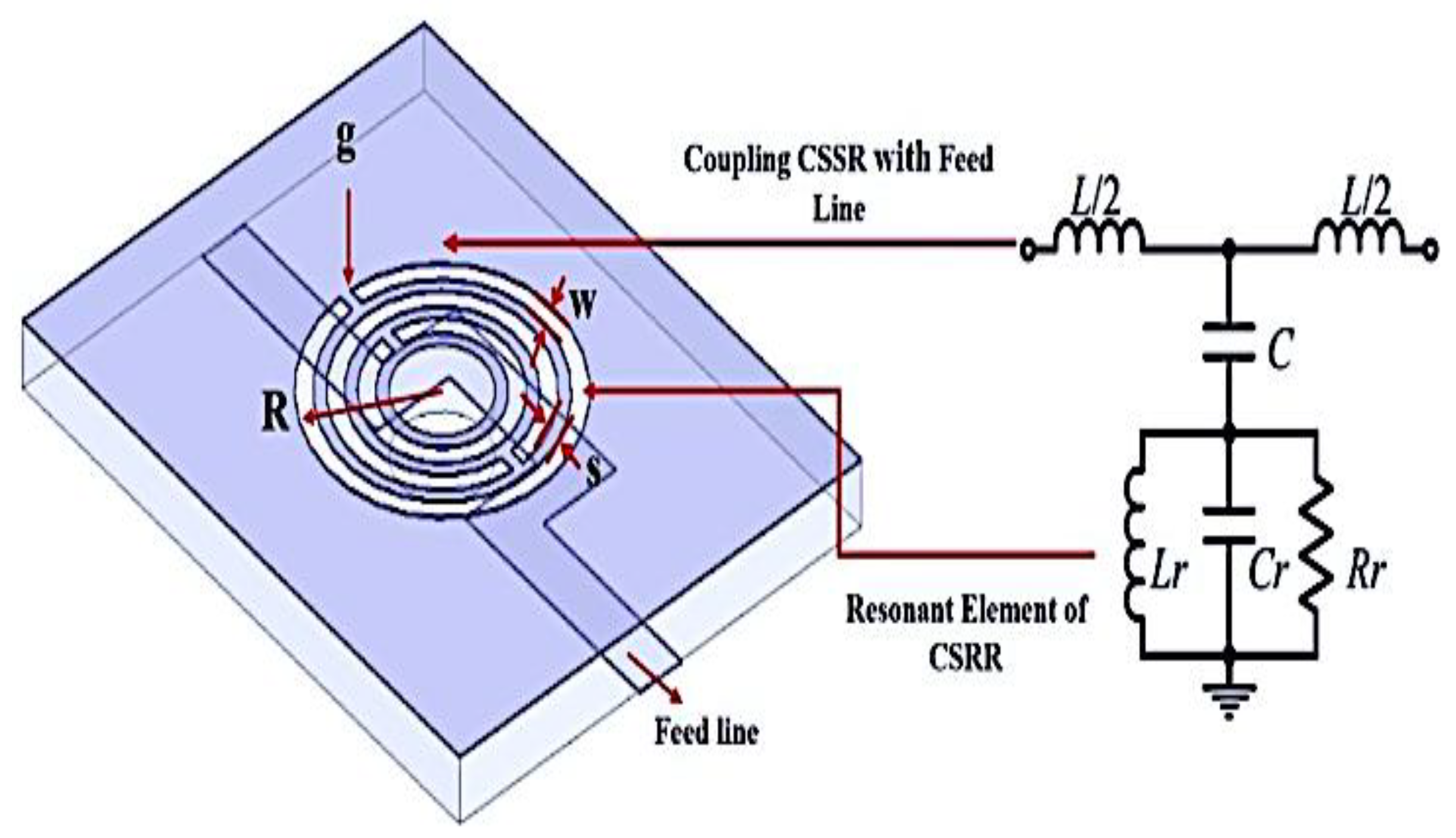

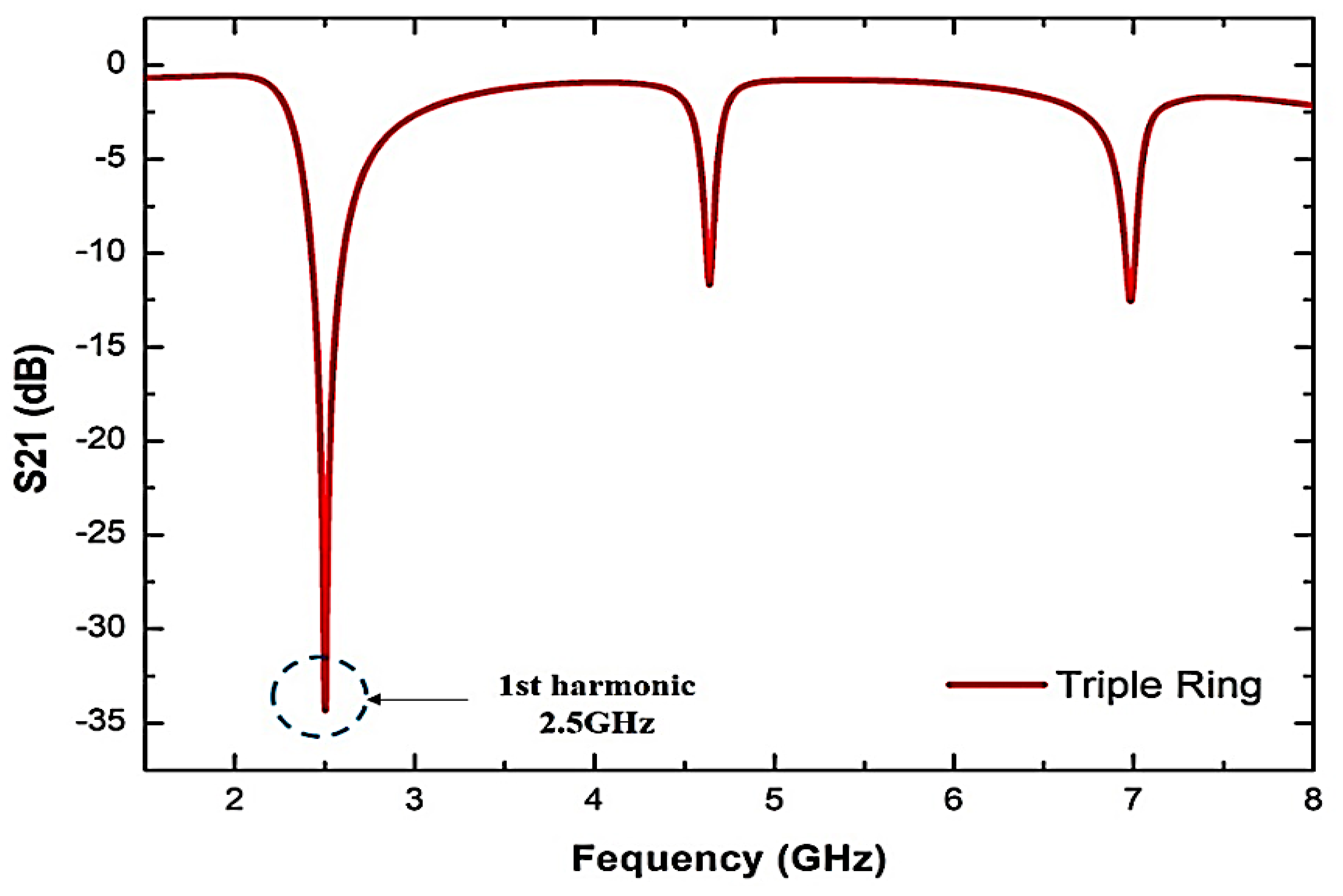
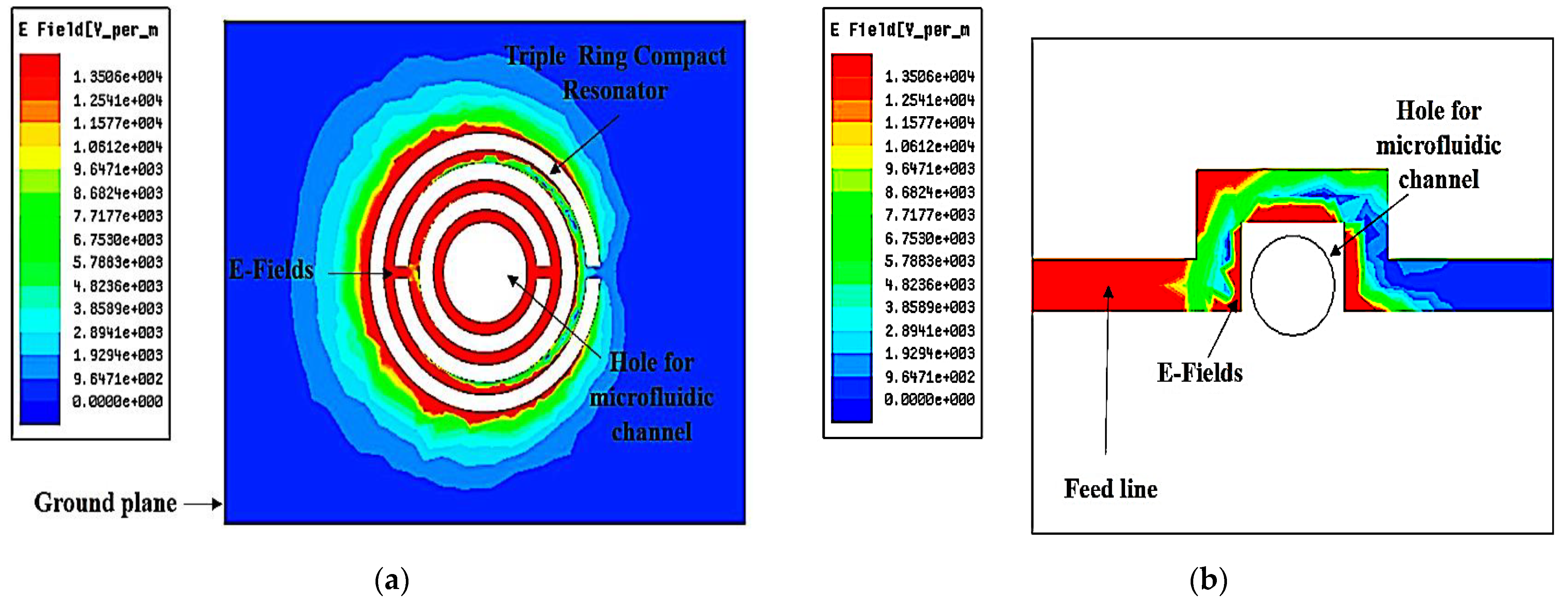
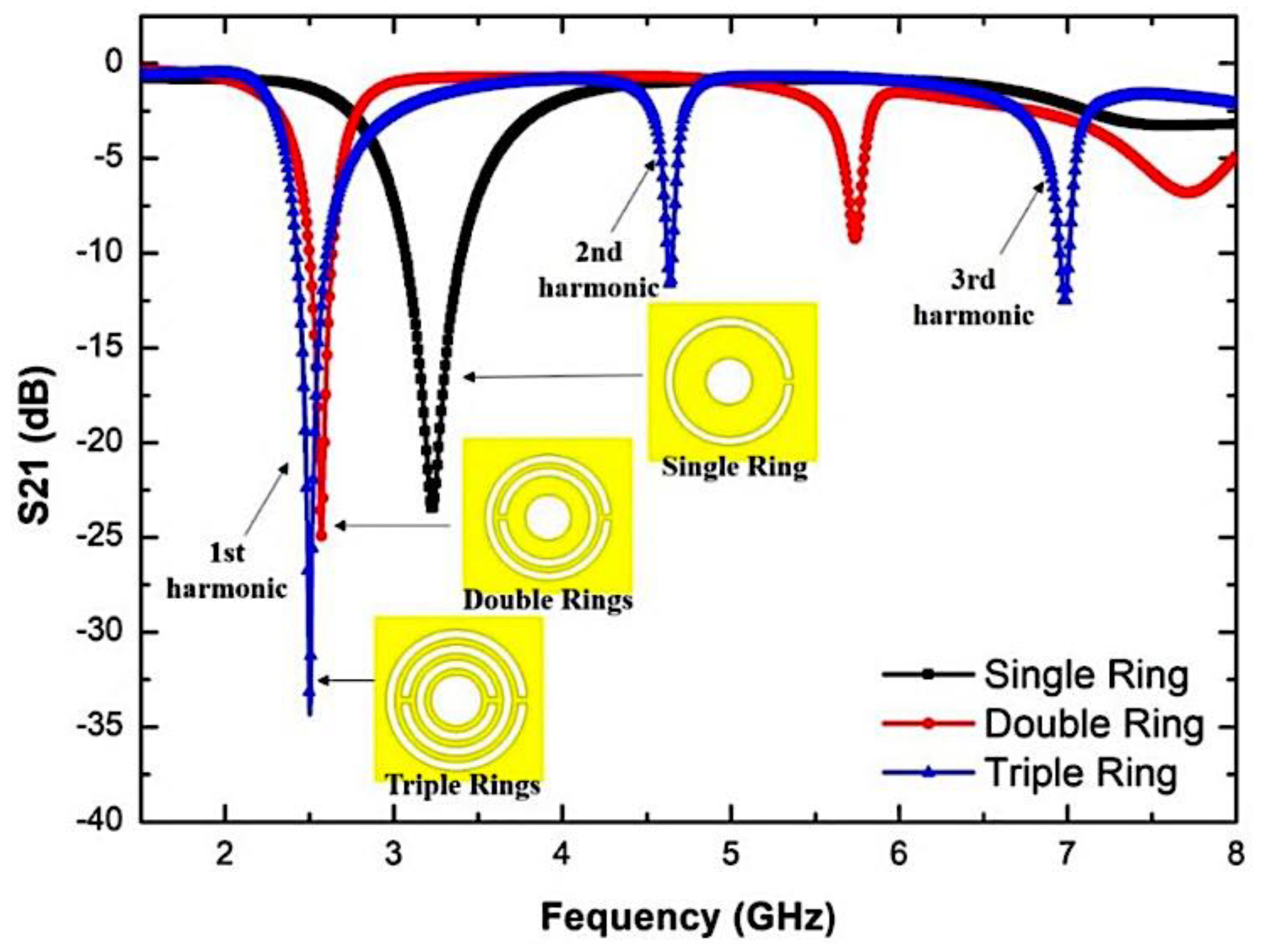


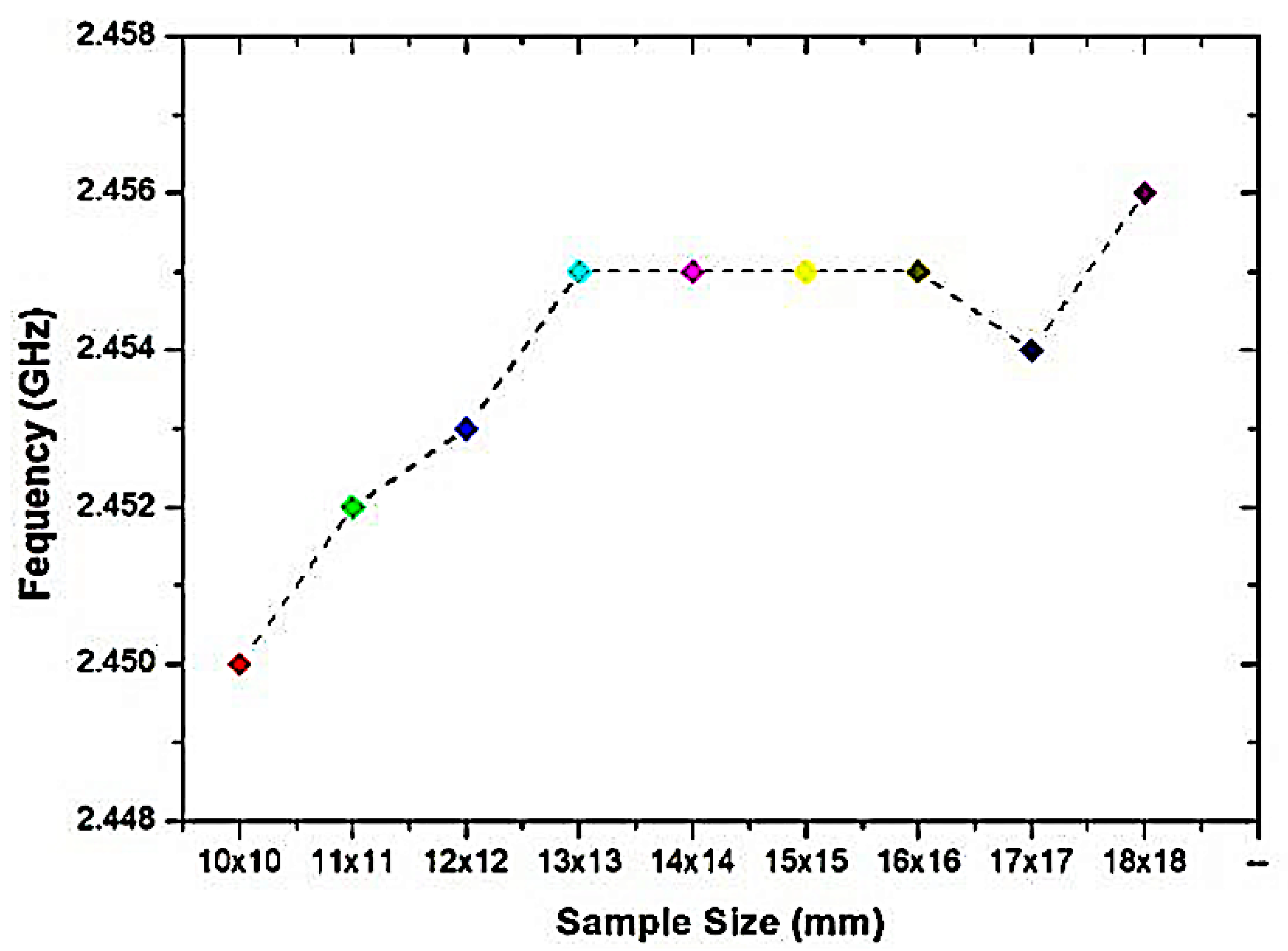
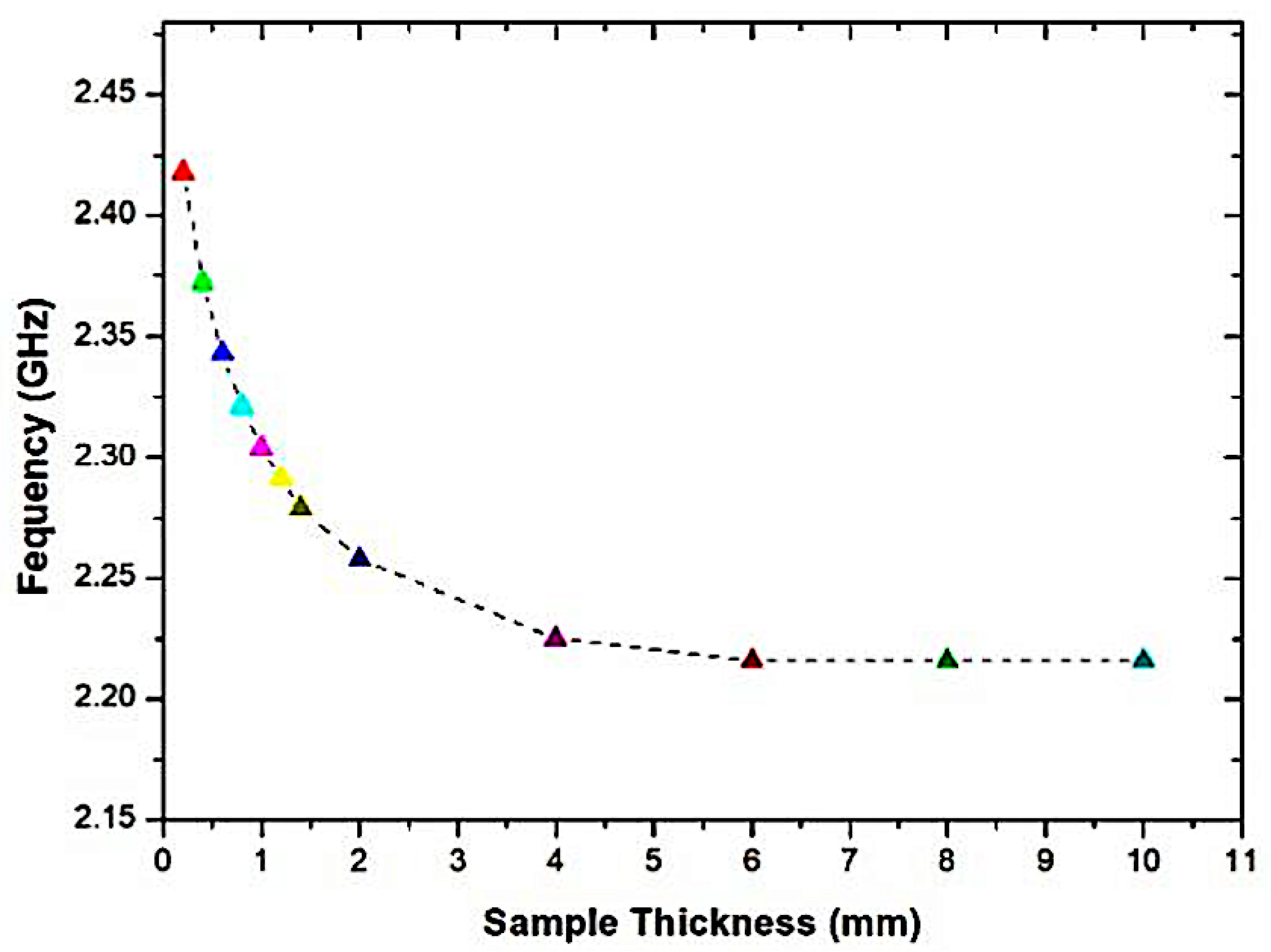
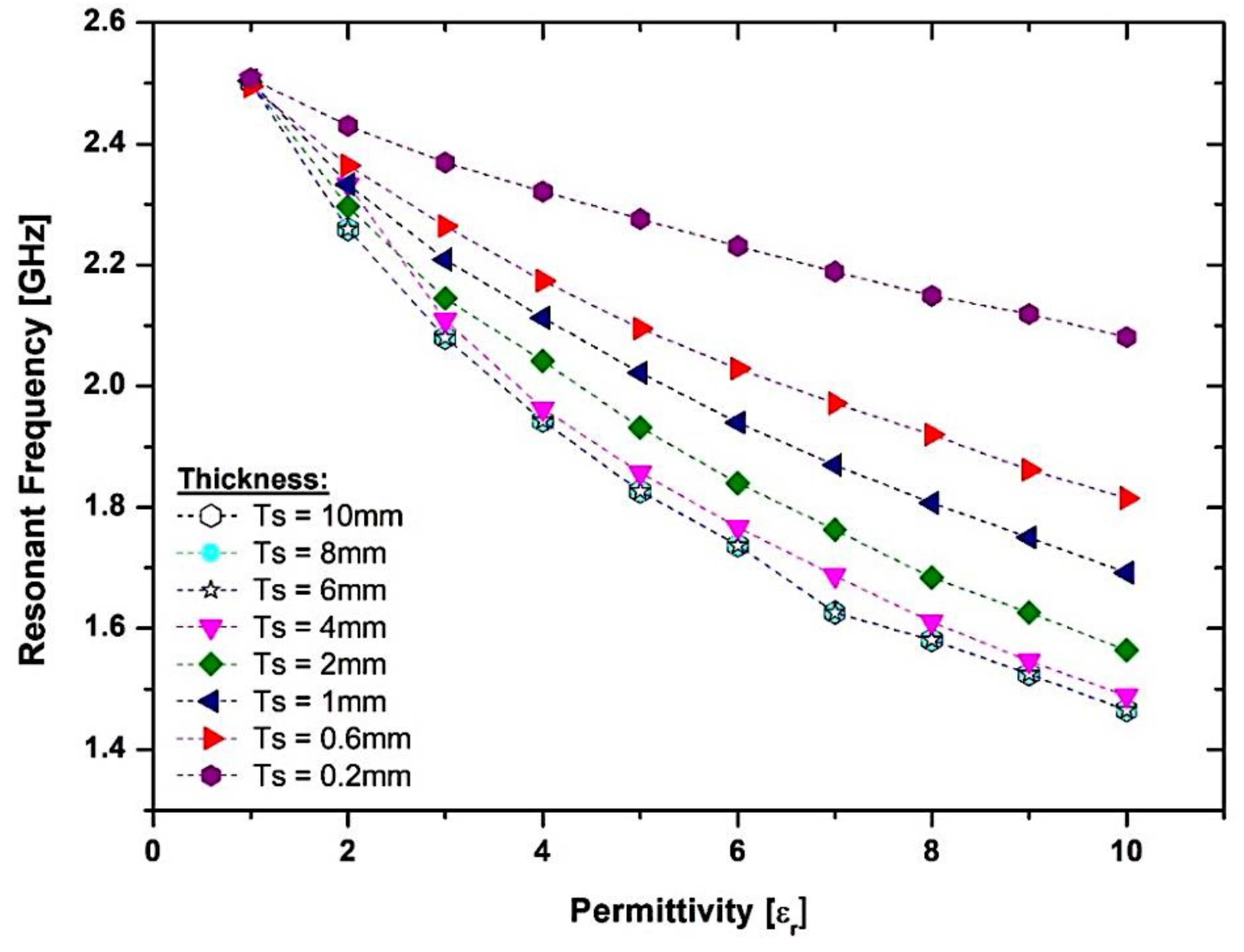
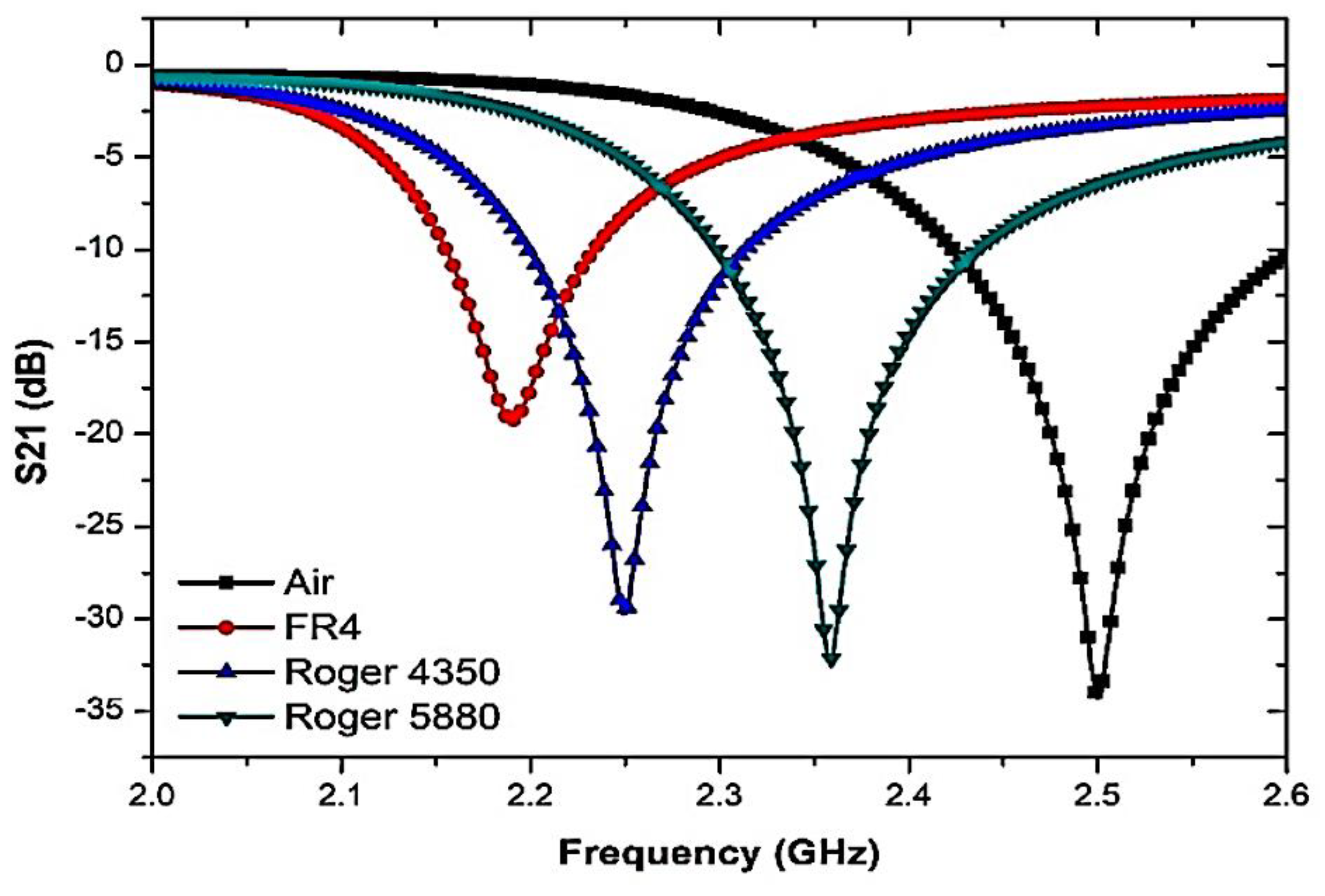
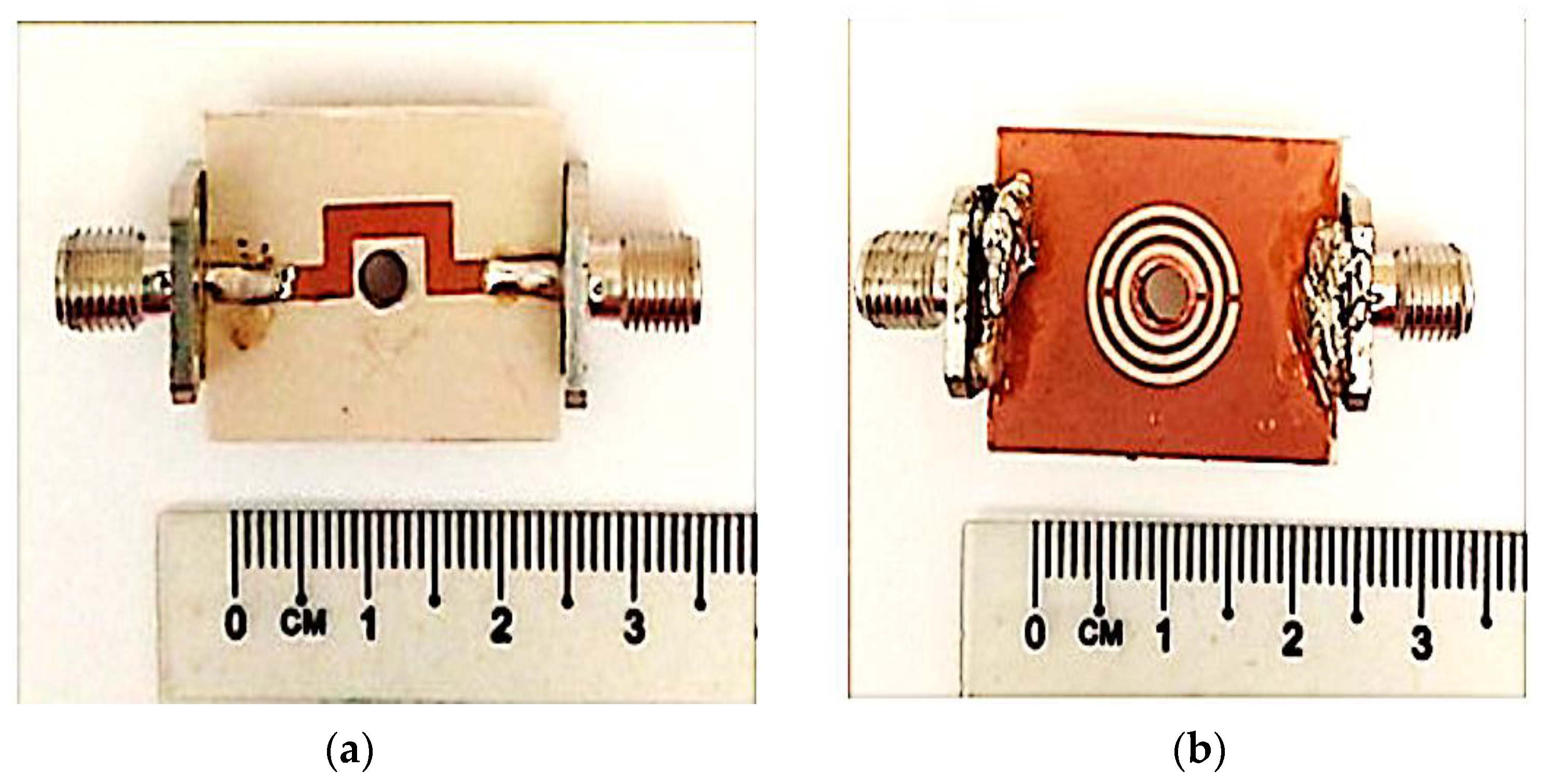
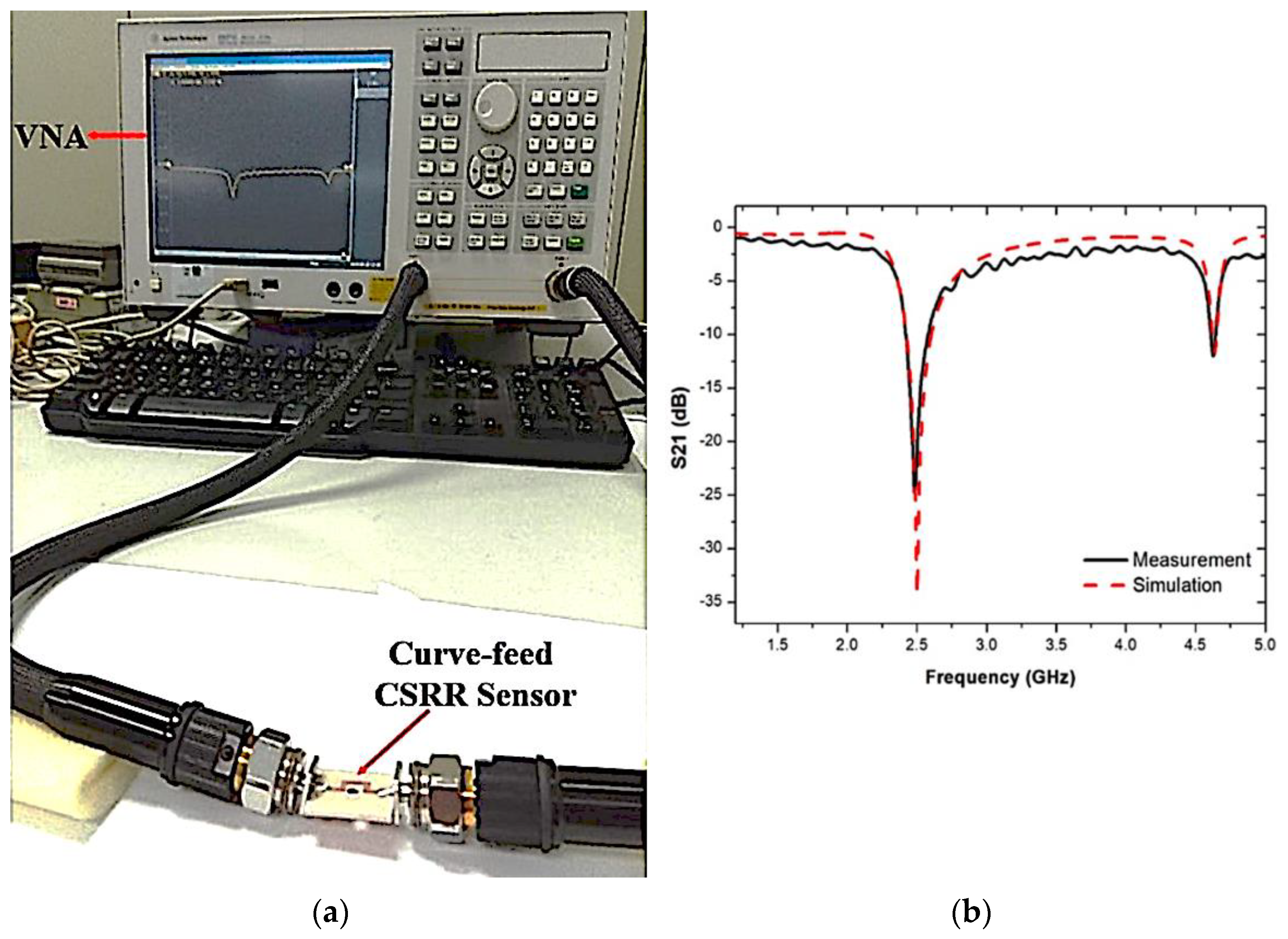



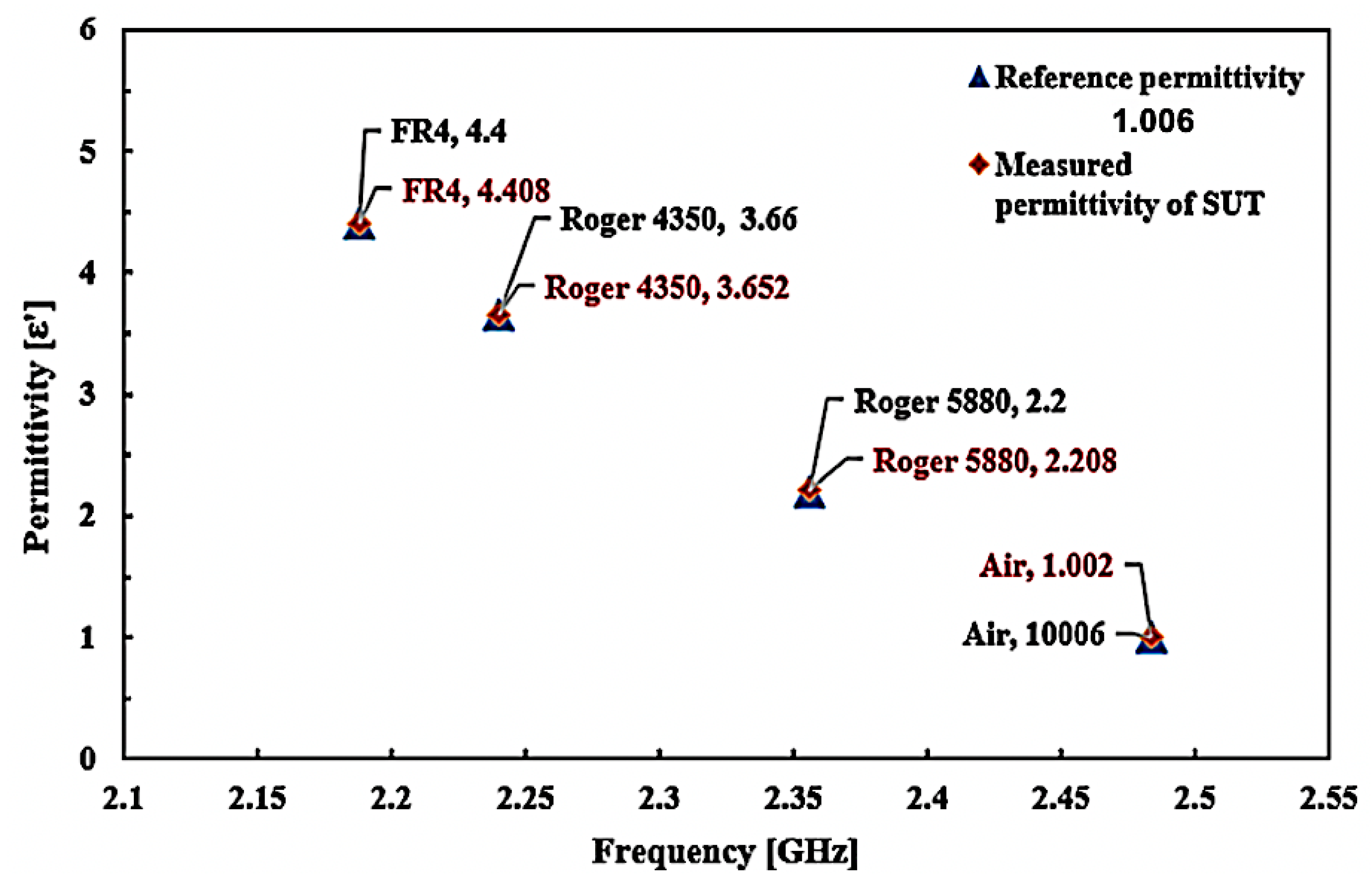
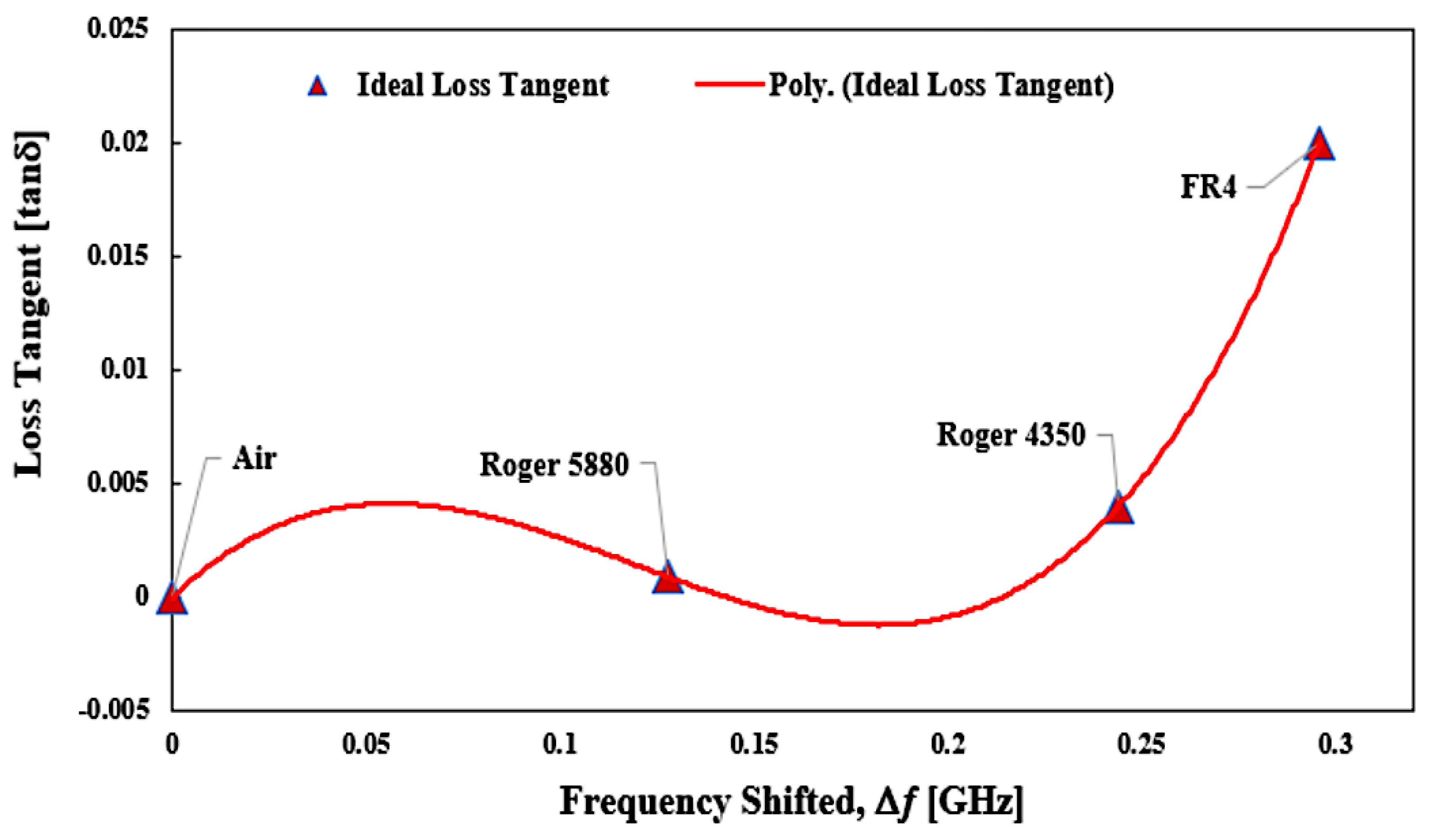

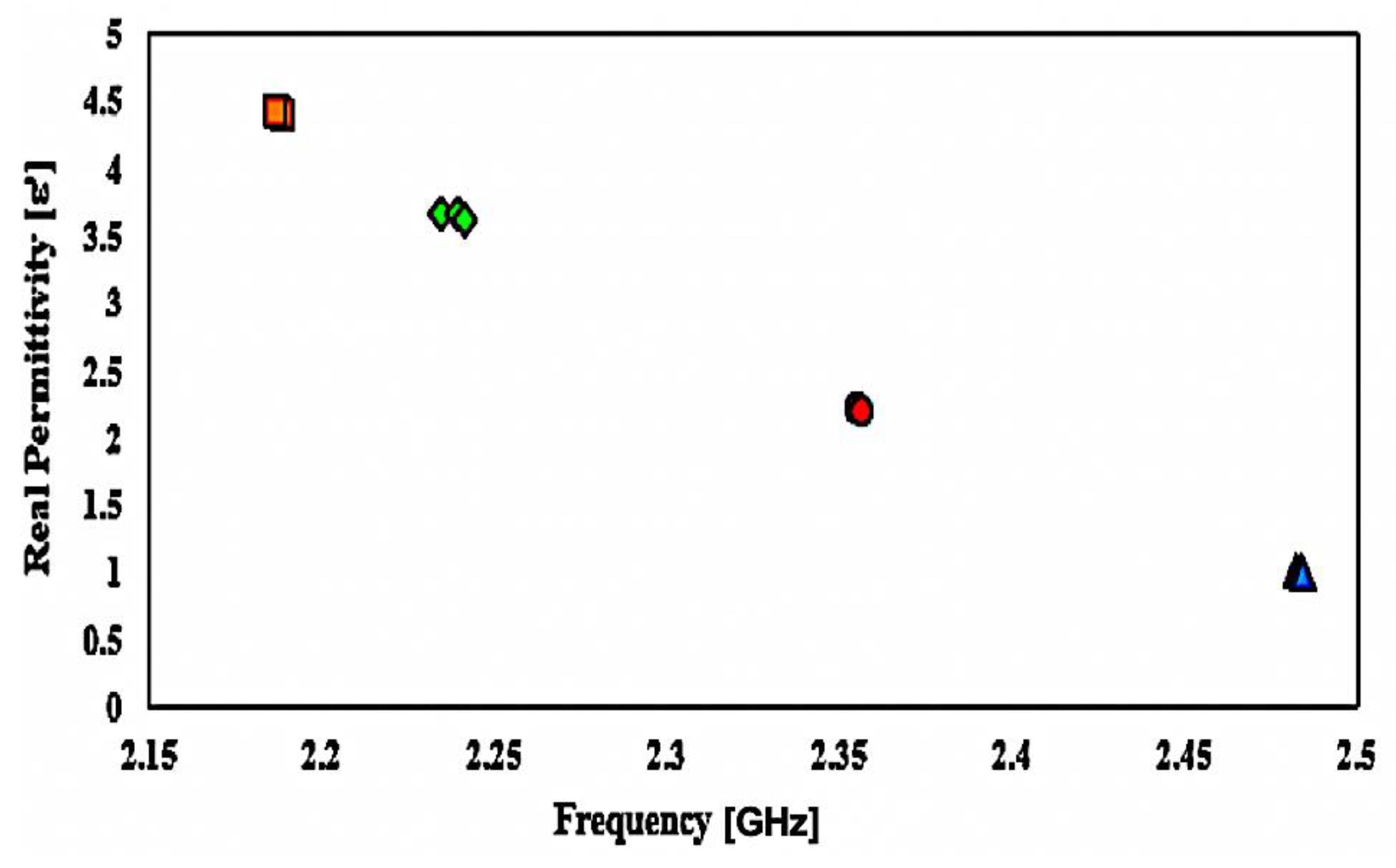
| # | References | Total Dimensions of the Proposed Sensors (mm) | Used Techniques | SUTs Samples | Frequency Band (GHz) | Q-Factor | Sensitivity (S) |
|---|---|---|---|---|---|---|---|
| 1 | [26] | 40 × 50 × 0.79 | Two Arms SRR | Solid | 2.27 | 240 | Not reported |
| 2 | [27] | 24 × 60 × 1.6 | DS-SRR | Coal | 4.75 | Not reported | Not reported |
| 3 | [28] | 74 × 136 × 0.5 | Coupled-Line | Liquid | 2.4 | Not reported | 0.75 |
| 4 | [29] | 38 × 35 × 15.73 | GWCR | Liquid | 5.96 | 66.8 | 0.156 |
| 5 | [31] | 70 × 70 × 1.6 | Star-Slotted Patch | Oil | 2.68 | 37.36 | 1.87 |
| 6 | [32] | Not reported | CSRR | Solid | 1.5, 2.45, 3.8, and 5.8 | Not reported | 1.15 at 1.5 GHz |
| 7 | [33] | Not reported | CSRR | Solid | 2.47 | 117.5 | 0.5 |
| 8 | [34] | 71.84 × 68.30 × 0.787 | SSRR | Solid | 2.22 | 267.07 | Not reported |
| 9 | [35] | 30 × 25 × 1.6 | CSSRRs | Solid | 5.35 and 7.99 | 267.5 | 0.04 |
| * This work | 25 × 20 × 1.52 | Curve-feed CSRR | Solid | 2.5 | 520 | 1.072 | |
| Parameters | L | W | FL | FW | RH | RW | Rg | Rs | R1 | R2 | R3 |
|---|---|---|---|---|---|---|---|---|---|---|---|
| Values (mm) | 25 | 20 | 28 | 2.1 | 2 | 0.68 | 0.5 | 0.5 | 5.54 | 3.18 | 3.18 |
| CSRR | Frequency (GHz) | Q-Factor | Insertion Loss, 𝑺21 (dB) | Electric Fields (v/m) |
|---|---|---|---|---|
| Single Ring | 3.23 | 91 | −32.476 | 9.8 × 103 |
| Double Ring | 2.57 | 220 | −24.949 | 1.33 × 104 |
| Triple Ring | 2.5 | 520 | −34.281 | 1.55 × 104 |
| SUTs | Frequency (GHz) | S21 (dB) | Frequency Shifted (MHz) |
|---|---|---|---|
| Without tube | 2.5 | −34.2808 | 0 |
| Roger 5880 | 2.358 | −32.2054 | 142 |
| Roger 4350 | 2.249 | −29.7105 | 251 |
| FR4 | 2.19 | −19.2484 | 310 |
| SUTs | Relative SUT Permittivity (εr) | Simulation | Measurement | ||
|---|---|---|---|---|---|
| Frequency (GHz) | S21 (dB) | Frequency (GHz) | S21 (dB) | ||
| Air | 1.0006 | 2.5 | −34.2808 | 2.484 | −24.7991 |
| Roger 5880 | 2.2 | 2.358 | −32.2054 | 2.356 | −23.6757 |
| Roger 4350 | 3.66 | 2.249 | −29.7105 | 2.24 | −22.6338 |
| FR4 | 4.4 | 2.19 | −19.2484 | 2.188 | −18.6323 |
| SUTs | Frequency (GHz) | Ideal Dielectric Constant | Proposed Sensor | * Commercial Sensor | ||
|---|---|---|---|---|---|---|
| Real Permittivity (ε′) | Error (%) | Real Permittivity (ε′) | Error (%) | |||
| Air | 2.484 | 1.0006 | 1.002 | 0.14 | 1.11 | 10.93 |
| Roger 5880 | 2.356 | 2.2 | 2.208 | 0.364 | 2.48 | 12.72 |
| Roger 4350 | 2.24 | 3.66 | 3.652 | 0.219 | 3.3 | 9.8 |
| FR4 | 2.188 | 4.4 | 4.408 | 0.182 | 4.42 | 0.45 |
| Average Error | 0.23% | 8.48% | ||||
| SUTs | Frequency Shifting (GHz) | Ideal Loss Tangent | Proposed Sensor | * Commercial Sensor | ||
|---|---|---|---|---|---|---|
| Loss Tangent (𝒕𝒂𝒏 𝜹) | Error (%) | Loss Tangent (𝒕𝒂𝒏 𝜹) | Error (%) | |||
| Air | 0 0 0 0 0 0 | 0 0 0 0 0 | 0 | 0 | 0 0 | 0 |
| Roger 5880 | 0.148 | 0.009 | 0.00089 | 0.0080 | 0.015 | 7.3 |
| Roger 4350 | 0.256 | 0.004 | 0.00398 | 0.0046 | 0.008 | 9.5 |
| Fr4 | 0.302 | 0.02 | 0.01997 | 0.0013 | 0.010 | 5.1 |
| Average error | 0.003% | 5.48% | ||||
| SUTs | Frequency, f (GHz) | Permittivity (ε’) | ||||||
|---|---|---|---|---|---|---|---|---|
| f1 | f2 | f3 | ε’1 | ε’2 | ε’3 | |||
| Air | 2.484 | 2.4823 | 2.4837 | 2.4848 | 1.002 | 1.0049 | 1.0041 | 0.9955 |
| Roger 5880 | 2.3559 | 2.3553 | 2.3555 | 2.3568 | 2.208 | 2.2098 | 2.2139 | 2.1996 |
| Roger 4350 | 2.239 | 2.2351 | 2.2394 | 2.2419 | 3.652 | 3.6690 | 3.6607 | 3.6260 |
| FR4 | 2.188 | 2.1875 | 2.1894 | 2.1867 | 4.408 | 4.4099 | 4.3866 | 4.4276 |
| SUTs | Frequency (GHz) | Δ𝒇 (MHz) | εr | Δεr | S [MHz/εr] |
|---|---|---|---|---|---|
| Air | 2.484 | 0 | 1.0006 | 0 | 0 |
| Roger 5880 | 2.356 | 128 | 2.2 | 1.194 | 1.072 |
| Roger 4350 | 2.24 | 244 | 3.66 | 2.654 | 0.919 |
| Fr4 | 2.188 | 296 | 4.4 | 3.394 | 0.872 |
Disclaimer/Publisher’s Note: The statements, opinions and data contained in all publications are solely those of the individual author(s) and contributor(s) and not of MDPI and/or the editor(s). MDPI and/or the editor(s) disclaim responsibility for any injury to people or property resulting from any ideas, methods, instructions or products referred to in the content. |
© 2023 by the authors. Licensee MDPI, Basel, Switzerland. This article is an open access article distributed under the terms and conditions of the Creative Commons Attribution (CC BY) license (https://creativecommons.org/licenses/by/4.0/).
Share and Cite
Al-Gburi, A.J.A.; Zakaria, Z.; Abd Rahman, N.; Alam, S.; Said, M.A.M. A Compact and Low-Profile Curve-Feed Complementary Split-Ring Resonator Microwave Sensor for Solid Material Detection. Micromachines 2023, 14, 384. https://doi.org/10.3390/mi14020384
Al-Gburi AJA, Zakaria Z, Abd Rahman N, Alam S, Said MAM. A Compact and Low-Profile Curve-Feed Complementary Split-Ring Resonator Microwave Sensor for Solid Material Detection. Micromachines. 2023; 14(2):384. https://doi.org/10.3390/mi14020384
Chicago/Turabian StyleAl-Gburi, Ahmed Jamal Abdullah, Zahriladha Zakaria, Norhanani Abd Rahman, Syah Alam, and Maizatul Alice Meor Said. 2023. "A Compact and Low-Profile Curve-Feed Complementary Split-Ring Resonator Microwave Sensor for Solid Material Detection" Micromachines 14, no. 2: 384. https://doi.org/10.3390/mi14020384
APA StyleAl-Gburi, A. J. A., Zakaria, Z., Abd Rahman, N., Alam, S., & Said, M. A. M. (2023). A Compact and Low-Profile Curve-Feed Complementary Split-Ring Resonator Microwave Sensor for Solid Material Detection. Micromachines, 14(2), 384. https://doi.org/10.3390/mi14020384







